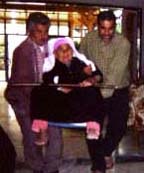|
Web
Exclusives:Features April
18, 2001: By Jeff Pojanowski '00
It was January 1, 2001, a month before the elections that would vault Ariel Sharon to the seat of Israeli Prime Minister, and the violence that propelled him there resulted in a shorter than usual wait in the foreign passport line at Tel Aviv's Ben Gurion Airport. The tourists were absent, but I was there with the Wheelchair Foundation, an international relief group dedicated to providing wheelchairs people around the globe who needed, but could not afford one. Since graduation the previous June, I had been working as the foundation's Washington, D.C., representative, serving as a liaison to the U.S. government and foreign embassies and performing research and other writing tasks. Even though I had to ring in the New Year somewhere over Albanian air space, it was an exciting change of pace to help the organization distribute wheelchairs to people in Tel Aviv and in the Gaza Strip.
Although part of work took place at an Israeli-run pediatric ward outside of Tel Aviv, the most memorable part of the journey began early the first morning, when we left from our hotel in Jerusalem. From there it was a 90-minute ride to the fenced off Gaza Strip, where I spent four days and had a firsthand look at one of the hotspots of the Arab-Israeli conflict. The entry to Gaza was closed off to most human traffic, and all cars were forbidden to cross, so we hefted our luggage across the 100-yard stretch of concrete and barbed wire to vans waiting on the Palestinian side of the no-man's land. That short, surreal hike was really a journey from the First World to the Third. We received a warm welcome from a Gaza City organization working with the disabled. Nevertheless, one could not ignore the atmosphere of nervous gloom pervading the Gaza Strip. Our visit came in the middle of the most recent Palestinian uprising against the Israelis. This uprising, which started in September 2000, brought daily fighting between the two groups and the collapse of the peace process. The conflict struck a lethal blow to a recent economic boom, and Gaza City was littered with the remains of more optimistic times. Half-constructed housing complexes were decaying to rubble, quietly mocking yesterday's hopes. Groups of idle men, jobless since the borders closed, lingered before cinder-block tenements and stained storefronts.
But one also sensed that things were not easy before the collapse, for meandering armies of shoeless toddlers and cavalries of rib-gaunt donkeys pulling carts do not appear overnight. The poverty in refugee camps was even more striking. As our U.N. guide explained, these haphazard conglomerations of brick, dust, and graffiti held as many as 70,000 people in one square kilometer. At many points the roads were only a meter wide, as growing generations built horizontal extensions to their houses, sprawling inward upon the camps' avenues. Once we set up improvised wheelchair-fitting stations in our hotel's ballroom and unloaded the wheelchairs we shipped, our mission was simple: Seat and fit as many people as possible. The way the foundation works is simple: It partners with local organizations that locate needy individuals. The foundation pays for the manufacture and shipping of the wheelchairs, and the local partner distributes and provides documentation and follow-up. In this case, however, we wanted to be on the ground to make sure everything went well. All day our team of foundation staffers and volunteer American technicians and therapists would work a local hotel ballroom, fitting the droves of Palestinians who came. In the Gaza Strip, like so many places in the developing world, a wheelchair is an empowering tool too expensive for most anyone to even dream about. Old men and women wearing traditional dress and proud faces were carried in on blankets and wooden boards, and parents bearing their children poured in from all corners of the region. One man who had emigrated from the U.S. back to the Gaza Strip in its better days had spent years searching for a wheelchair for his daughter, and in one family alone, twin boys and one girl left with new wheelchairs and stuffed animals. Although we were never in direct danger, we worked in the shadow of violence. Many people needing chairs were trapped behind internal roadblocks, and there were stories that people attempting to reach us via a nearby beach were fired upon. During the day, the walls rumbled with explosions from fighting at a settlement six kilometers away, and at night the boom of artillery mingled with the crashing of the Mediterranean's waves. Conflict also increased the scope of our work, as the poverty that accompanies unrest spreads disability while reducing the capacity to treat it. After I returned and reflected on the experience, it was clear that Gaza is not a place for simple answers. Although no expert on the region's politics, I grew to further resent hardliners who thrive on propelling the conflict. I saw injustice in the Israeli fences that strangle all Palestinians for the actions of a radical minority, but I felt equally frustrated with a Palestinian government that delivers inflammatory television propaganda more efficiently than foreign aid money. One thing is certain, though, and it is written in angry spray paint on the city walls. Gaza's soaring population growth and abysmal living conditions are fertile soils for sowers of militancy. Without a peaceful solution soon, things will get much worse there, and recent crackdowns on the area only fuel the fires of discontent. Jeff Pojanowski was a Woodrow Wilson School major, and plans to start Harvard Law School in September.
|
|||||||



